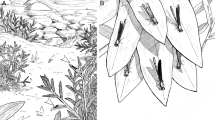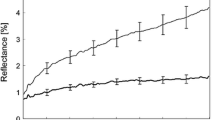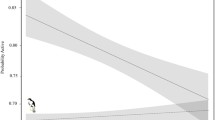Abstract
Female mimicry by males is a widespread phenomenon in several taxa and may be involved in aggression avoidance or facilitated access to resources. In early developmental stages, female mimicry may be a mechanism involved in signalling sexual immaturity or, when coupled with strategies related to visual camouflage, may be involved in the avoidance of male-male agonistic interactions. Here, we addressed whether the delayed colour maturation of a sexual ornament in males of Mnesarete pudica damselflies might be a case of crypsis, female mimicry or both. We analysed how conspecifics and predators perceive the pigmented wings of juvenile males by contrasting the wing spectra against a savannah background and the wings of both juvenile and sexually mature males and females. Our results based on the modelled visual system of conspecifics and predators suggest that the colour maturation of juvenile males may function as both crypsis and female mimicry. We discuss whether these results related to age- and sexual-dichromatism might be a mechanism to avoid unwanted intraspecific interactions or to avoid territorial and aggressive males. We conclude that the female mimicry and crypsis in juvenile males of M. pudica are mechanisms involved in avoidance of predators and unwanted intraspecific interactions, and the signalling of sexual maturity.



Similar content being viewed by others
References
M Andersson 1994 Sexual selection Princeton University Press Princeton, New Jersey
CD Beatty JA Andrés TN Sherratt 2015 Conspicuous coloration in males of the damselfly Nehalenniairene (Zygoptera: Coenagrionidae): do males signal their unprofitability to other males? PLoS ONE 10 e0142684 https://doi.org/10.1371/journal.pone.0142684
CL Booth 1990 Evolutionary significance of ontogenetic colour change in animals Biol J Linn Soc 40 125 163 https://doi.org/10.1111/j.1095-8312.1990.tb01973.x
T Caro TN Sherratt M Stevens 2016 The ecology of multiple colour defences Evol Ecol 30 797 809 https://doi.org/10.1007/s10682-016-9854-3
GC Carpenter 1995 The ontogeny of a variable social badge: throat color development in tree lizards (Urosaurus ornatus) J Herpetol 29 7 https://doi.org/10.2307/1565079
G Chen C **a L Dong 2019 Delayed plumage maturation in green-backed flycatchers (Ficedula elisae): an evidence of female mimicry Ethology 125 64 72 https://doi.org/10.1111/eth.12825
J Cohen 1988 Statistical power analysis for the behavioral sciences 2 Academic Press New York
J Contreras-Garduño J Canales-Lazcano A Córdoba-Aguilar 2006 Wing pigmentation, immune ability, fat reserves and territorial status in males of the rubyspot damselfly, Hetaerinaamericana J Ethol 24 165 173 https://doi.org/10.1007/s10164-005-0177-z
PS Corbet 1999 Dragonflies: behaviours and ecology of Odonata Harley books Colchester, UK
A Cordero 1990 The inheritance of female polymorphism in the damselfly Ischnura graellsii (Rambur) (Odonata: Coenagrionidae) Heredity (edinb) 64 341 346 https://doi.org/10.1038/hdy.1990.42
A Córdoba-Aguilar 2008 Dragonflies and damselflies: model organisms for ecological and evolutionary research Oxford University Press
RC Duarte AAV Flores M Stevens 2017 Camouflage through colour change: mechanisms, adaptive value and ecological significance Philos Trans R Soc B Biol Sci 372 20160342 https://doi.org/10.1098/rstb.2016.0342
A Forsyth J Alcock 1990 Female mimicry and resource defense polygyny by males of a tropical rove beetle, Leistotrophus versicolor (Coleoptera : Staphylinidae) Behav Ecol Sociobiol 26 325 330 https://doi.org/10.1007/BF00171097
AM Fraser TB Herman 1993 Territorial and reproductive behaviour in a sympatric species complex of the neotropical damselfly Cora Selys (Zygoptera: Polythoridae) Odonatologica 22 411 429
I Gonzáles-Santoyo D González-Tokman M Tapia-Rodríguez A Córdoba-Aguilar 2021 What doesn’t kill you makes you stronger: detoxification ability as a mechanism of honesty in a sexually selected signal Funct Ecol 35 1666 1678 https://doi.org/10.1111/1365-2435.13798
FM Gawryszewski PC Motta 2012 Colouration of the orb-web spider Gasteracantha cancriformis does not increase its foraging success Ethol Ecol Evol 24 23 38 https://doi.org/10.1080/03949370.2011.582044
EJ Gering 2017 Male-mimicking females increase male-male interactions, and decrease male survival and condition in a female-polymorphic damselfly Evolution (n y) 71 1390 1396 https://doi.org/10.1111/evo.13221
R Guillermo-Ferreira 2021 Wing-clap** in Mnesarete pudica—a mating call? Odonatologica 50 43 54 https://doi.org/10.5281/zenodo.4746238
R Guillermo-Ferreira PC Bispo 2012a Male and female interactions during courtship of the Neotropical damselfly Mnesarete pudica (Odonata: Calopterygidae) Acta Ethol 15 173 178 https://doi.org/10.1007/s10211-012-0122-4
R Guillermo-Ferreira PC Bispo 2012b Description of the larva of Mnesarete pudica (Hagen in Selys, 1853) (Odonata: Calopterygidae) and notes on known genera of South American Calopterygidae larvae Zootaxa 3482 77 81
R Guillermo-Ferreira SN Gorb E Appel 2015 Variable assessment of wing colouration in aerial contests of the red-winged damselfly Mnesarete pudica (Zygoptera, Calopterygidae) Sci Nat 102 13 https://doi.org/10.1007/s00114-015-1261-z
R Guillermo-Ferreira EM Therézio MH Gehlen 2014 The role of wing pigmentation, UV and fluorescence as signals in a Neotropical damselfly J Insect Behav 27 67 80 https://doi.org/10.1007/s10905-013-9406-4
R Guillermo-Ferreira DS Vilela K Del-claro PC Bispo 2016 Erythrodiplax ana sp nov (Odonata: Libellulidae) from Brazilian palm swamps Zootaxa 4158 292 300 https://doi.org/10.11646/zootaxa.4158.2.10
NS Hart JC Partridge IC Cuthill ATD Bennett 2000 Visual pigments, oil droplets, ocular media and cone photoreceptor distribution in two species of passerine bird: the blue tit (Parus caeruleus L.) and the blackbird (Turdus merula L.) J Comp Physiol A Sensory, Neural, Behav Physiol 186 375 387 https://doi.org/10.1007/s003590050437
RE Hooper SJ Plaistow Y Tsubaki 2006 Signal function of wing colour in a polymorphic damselfly, Mnais costalis Selys (Zygoptera: Calopterygidae) Odonatologica 35 15 22
RE Hooper Y Tsubaki MT Siva-Jothy 1999 Expression of a costly, plastic secondary sexual trait is correlated with age and condition in a damselfly with two male morphs Physiol Entomol 24 364 369 https://doi.org/10.1046/j.1365-3032.1999.00152.x
S-C Huang J Reinhard 2012 Color change from male-mimic to gynomorphic: a new aspect of signaling sexual status in damselflies (Odonata, Zygoptera) Behav Ecol 23 1269 1275 https://doi.org/10.1093/beheco/ars112
S Joshi D Agashe 2020 Ontogenic colour change, survival, and mating in the damselfly Agriocnemis pygmaea Rambur (Insecta: Odonata) Ecol Entomol 45 1015 1024 https://doi.org/10.1111/een.12879
MK Khan 2020 Female prereproductive coloration reduces mating harassment in damselflies Evolution 74 2293 2303 https://doi.org/10.1111/evo.14048
MK Khan ME Herberstein 2020 Ontogenetic colour change signals sexual maturity in a non-territorial damselfly Ethology 126 51 58 https://doi.org/10.1111/eth.12959
YA Kram S Mantey JC Corbo 2010 Avian cone photoreceptors tile the retina as five independent, self-organizing mosaics PLoS ONE 5 e8992 https://doi.org/10.1371/journal.pone.0008992
NE Langmore M Stevens G Maurer 2011 Visual mimicry of host nestlings by cuckoos Proc R Soc B Biol Sci 278 2455 2463 https://doi.org/10.1098/rspb.2010.2391
C Luo C Wei 2015 Intraspecific sexual mimicry for finding females in a cicada: males produce “female sounds” to gain reproductive benefit Anim Behav 102 69 76 https://doi.org/10.1016/j.anbehav.2015.01.013
R Maia CM Eliason PP Bitton 2013 pavo: an R package for the analysis, visualization and organization of spectral data Methods Ecol Evol 4 906 913 https://doi.org/10.1111/2041-210X.12069
R Maia H Gruson JA Endler TE White 2019 pavo 2: new tools for the spectral and spatial analysis of colour in R Methods Ecol Evol 10 1097 1107 https://doi.org/10.1111/2041-210X.13174
IA Meinertzhagen R Menzel G Kahle 1983 The identification of spectral receptor types in the retina and lamina of the dragonfly Sympetrum rubicundulum J Comp Physiol A 151 295 310 https://doi.org/10.1007/BF00623906
AT Oliveira-Filho JA Ratter 2002 Vegetation physiognomies and woody flora of the Cerrado biome PS Oliveira RJ Marquis Eds The Cerrados of Brazil Columbia University Press 91 120
P Olsson O Lind A Kelber 2018 Chromatic and achromatic vision: parameter choice and limitations for reliable model predictions Behav Ecol 29 273 282 https://doi.org/10.1093/beheco/arx133
D Outomuro L Söderquist F Johansson 2017 The price of looking sexy: visual ecology of a three-level predator–prey system Funct Ecol 31 707 718 https://doi.org/10.1111/1365-2435.12769
P Pena-Firme R Guillermo-Ferreira 2020 Females of the red damselfly Mnesarete pudica are attracted to more ornamented males and attract rival males Sci Rep 10 1 7 https://doi.org/10.1038/s41598-020-71057-z
SJ Plaistow Y Tsubaki 2000 A selective trade–off for territoriality and non–territoriality in the polymorphic damselfly Mnaiscostalis Proc R Soc London Ser B Biol Sci 267 969 975 https://doi.org/10.1098/rspb.2000.1098
R Core Team (2021) R: a language and environment for statistical computing. R Foundation for Statistical Computing, Vienna, Austria
G-P Saetre T Slagsvold 1996 The significance of female mimicry in male contests Am Nat 147 981 995 https://doi.org/10.1086/285889
RA Sánchez-Guillén S Ceccarelli F Villalobos 2020 The evolutionary history of colour polymorphism in Ischnura damselflies Odonatologica 49 333 370
I Sanmartín-Villar H Zhang A Cordero-Rivera 2017 Ontogenetic colour changes and male polymorphism in Mnais andersoni (Odonata: Calopterygidae) Int J Odonatol 20 53 61 https://doi.org/10.1080/13887890.2017.1329754
TD Schultz OM Fincke 2013 Lost in the crowd or hidden in the grass: signal apparency of female polymorphic damselflies in alternative habitats Anim Behav 86 923 931 https://doi.org/10.1016/j.anbehav.2013.08.008
R Shine B Phillips H Waye 2001 Benefits of female mimicry in snakes Nature 414 267 267 https://doi.org/10.1038/35104687
A Siddiqi TW Cronin ER Loew 2004 Interspecific and intraspecific views of color signals in the strawberry poison frog Dendrobates pumilio J Exp Biol 207 2471 2485 https://doi.org/10.1242/jeb.01047
J Stangel D Preininger M Sztatecsny W Hödl 2015 Ontogenetic change of signal brightness in the foot-flagging frog species Staurois parvus and Staurois guttatus Herpetologica 71 1 7 https://doi.org/10.1655/HERPETOLOGICA-D-14-00014
A Sternalski F Mougeot V Bretagnolle 2012 Adaptive significance of permanent female mimicry in a bird of prey Biol Lett 8 167 170 https://doi.org/10.1098/rsbl.2011.0914
M Stevens S Merilaita 2011 Animal camouflage M Stevens S Merilaita Eds Animal camouflage Cambridge University Press Cambridge 1 16
Y Takahashi G Morimoto M Watanabe 2012 Ontogenetic colour change in females as a function of antiharassment strategy Anim Behav 84 685 692 https://doi.org/10.1016/j.anbehav.2012.06.025
LA Taylor DL Clark KJ McGraw 2014 From spiderling to senescence: ontogeny of color in the jum** spider, Habronattus pyrrithrix J Arachnol 42 268 276 https://doi.org/10.1636/0161-8202-42.3.268
The Jamovi Project (2021) jamovi. (Version 1.6) [Computer Software]. URL https://www.jamovi.org
R Thornhill 1979 Adaptive female-mimicking behavior in a scorpionfly Science 205 412 414 https://doi.org/10.1126/science.205.4404.412
DS Vilela R Koroiva A Cordero-Rivera R Guillermo-Ferreira 2019 A further study on Franciscobasis Machado & Bedê, 2016 (Odonata: Coenagrionidae), a newly described genus from Minas Gerais Brazil Plos One 14 e0223241 https://doi.org/10.1371/journal.pone.0223241
DS Vilela L Samuel Ricioli K Del-Claro R Guillermo-Ferreira 2017 Female color polymorphism of Ischnura capreolus Hagen, 1861 (Odonata: Coenagrionidae) with notes on behavior and ontogenetic color changes Int J Odonatol 20 191 200 https://doi.org/10.1080/13887890.2017.1373152
M Vorobyev D Osorio 1998 Receptor noise as a determinant of colour thresholds Proc R Soc B Biol Sci 265 351 358 https://doi.org/10.1098/rspb.1998.0302
M Watanabe M Taguchi 1990 Mating tactics and male wing dimorphism in the damselfly, Mnais pruinosa costalis Selys (Odonata: Calopterygidae) J Ethol 8 129 137 https://doi.org/10.1007/BF02350283
MJ Whiting JK Webb JS Keogh 2009 Flat lizard female mimics use sexual deception in visual but not chemical signals Proc R Soc B Biol Sci 276 1585 1591 https://doi.org/10.1098/rspb.2008.1822
C Winfrey OM Fincke 2017 Role of visual and non-visual cues in damselfly mate recognition Int J Odonatol 20 43 52 https://doi.org/10.1080/13887890.2017.1297259
Acknowledgements
RRC thanks Conselho Nacional de Desenvolvimento Científico e Tecnológico (CNPq) for a scholarship funding (Proc. 147742/2018-8 and Proc. 130346/2020-9). RGF thanks CNPq (Proc. 307836/2019-3) for financial support. EMT thanks INCT/INEO (Brazil), FAPEMAT (Process: 0273976/2017) and the Government of the State of Mato Grosso.
Funding
Conselho Nacional de Desenvolvimento Científico e Tecnológico
Author information
Authors and Affiliations
Corresponding author
Additional information
Communicated by: José Eduardo Serrão
Publisher's note
Springer Nature remains neutral with regard to jurisdictional claims in published maps and institutional affiliations.
Rights and permissions
About this article
Cite this article
Cezário, R.R., Therézio, E.M., Marletta, A. et al. Ontogenetic colour change of a sexual ornament in males of a damselfly: female mimicry, crypsis or both?. Sci Nat 109, 2 (2022). https://doi.org/10.1007/s00114-021-01775-5
Received:
Revised:
Accepted:
Published:
DOI: https://doi.org/10.1007/s00114-021-01775-5




